In the dead of night, a fleet of trucks would move down Mississippi Highway 90, hauling asphalt for an overlay project. To most, this would look like the model of logistical precision. But behind the scenes, Jacob Hickman, Asset Manager at Huey P Stockstill LLC (HPS), saw something different: despite making quick turns at the plant, trucks were waiting at the jobsite for up to an hour to unload. How did he know? Simple. Digital load tracking.
Across the United States, there has been a quiet transition in how roadwork fleets are managed. Contractors have been facing mounting pressure to do more with less—meaning fewer delays, tighter budgets, and a growing expectation around providing transparency to stakeholders. As a result, supervisors are putting down industry-standard radios and spreadsheets, and picking up tablets to monitor their trucks instead.
Huey P Stockstill LLC (HPS), Southern Mississippi and Louisiana’s most prominent asphalt paving and construction company, has been among the early adopters of digital load tracking.
“If you can measure it, you can manage it,” says Hickman.” “By measuring our trucking, we’ve become more efficient and saved significant money.”
Breakthrough Operational Efficiency
HPS first piloted the FleetWatcher Materials Management Solution in the summer of 2019 with the goal of boosting trucking efficiency. What they discovered on their overlay project on Mississippi Highway 90 between Gulfport and Bay St. Louis surprised them.
For hauling 40 thousand tons of asphalt, Hickman had initially tasked 10-16 trucks for the project. Each truck could cycle the 15 miles from its Gulfport asphalt plant. With one look at their digital load tracking software, Hickman could see the trucks sitting idle and was able to decide to do more with less and pull two trucks to use them to haul different material.
“When we pulled the two trucks, each truck had an average of one to two loads more than it previously did. We greatly reduced the amount of wait time on the job while still achieving the same amount of tons on the project. The same job was accomplished with fewer trucks, an ‘aha’ moment for us,” Hickman stressed. “Total time on the jobsite declined from about 1 hour to roughly 20 minutes.”
The efficiency gains from implementing digital load tracking weren’t unique to HPS. Around the country, contractors who implement digital load tracking are seeing similar results. E.R. Snell, running multi-divisional operations across Georgia, issued trackers to third-party trucking vendors to streamline dispatch communications. According to Asphalt Administrator for E.R. Snell, Caleb Hollis, “Before FleetWatcher, dispatch was handled by text and phone calls. To say the least, it was a mess.” It was not always clear who each truck was working for. Now, the team always knows who a truck is working for and knows exactly where they can be reached.
Cutting Costs for Fleet Operations
For roadwork fleets operating with tight budgets, digital load tracking such as FleetWatcher translates directly into dollars. In HPS’s case, repurposing two trucks led to an additional 20 thousand dollars in savings per truck.
“By using those two extra trucks for other jobs, as we did during the pilot project, we earned money we wouldn’t have otherwise captured,” Hickman explained. “For example, each extra truck we pulled from the pilot project can make $100 an hour for 10 hours each day. That quickly escalates to $20,000 per truck over the life of a 20-day project.”
But cost savings do not stop there. With real-time data on trucks, contractors can reduce fuel consumption, extend truck lifespans, and optimize labor use amidst the shortage. Over multiple projects and years, the cost savings add up and allow businesses to reinvest in their work.
Real-Time Data as an Industry-Wide Shift
The ability to validate decisions and track trends has improved buy-in across teams with a single source of truth. “It helps us with accountability and lets us know where our primary focus should be. Where do we need to get better? Nobody has to blame someone or come up with opinions. Instead, what can we adjust?” says Hickman. “By looking at our trucking operations, we have really changed the whole way we’ve looked at our business. It has given us the tools we need to challenge ourselves to get better and see our errors. So, for that, we’re very thankful.”
Looking ahead, modernizing fleet management through technology such as digital load tracking will ultimately mean less guesswork and more control over roadwork fleets.


